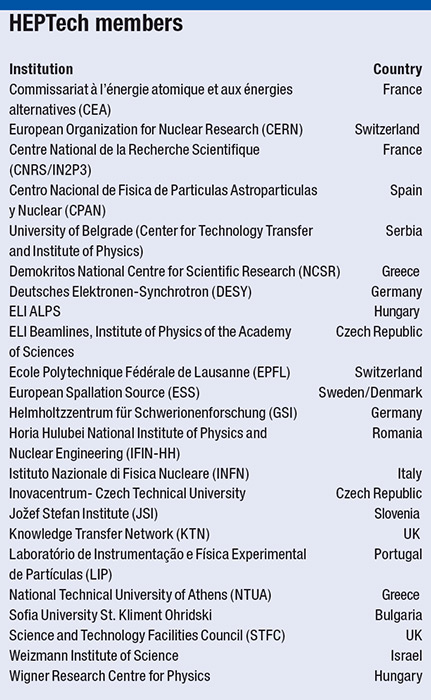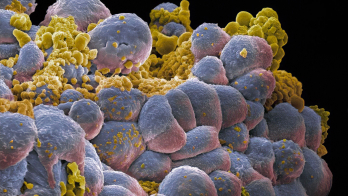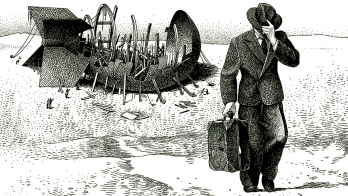Innovative approaches for technology transfer in Europe.

Image credit: CERN-PHOTO-201412-257-2.
Technologies developed for fundamental research in particle, astro-particle and nuclear physics have an enormous impact on everyday lives. To push back scientific frontiers in these fields requires innovation: new ways to detect one signal in a wealth of data, new techniques to sense the faintest signals, new detectors that operate in hostile environments, new engineering solutions that strive to improve on the best – and many others.
The scientific techniques and high-tech solutions developed by high-energy physics can help to address a broad range of challenges faced by industry and society – from developing more effective medical imaging and cancer diagnosis through positron-emission tomography techniques, to developing the next generation of solar panels using ultra-high vacuum technologies. However, it is difficult and costly not only for many organizations to carry out the R&D needed to develop new applications, products and processes, but also for scientists and engineers to turn their technologies into commercial opportunities.
The aim of the high-energy physics technology-transfer network – HEPTech – is to bring together leading European high-energy physics research institutions so as to provide academics and industry with a single point of access to the skills, capabilities, technologies and R&D opportunities of the high-energy physics community in a highly collaborative open-science environment. As a source of technology excellence and innovation, the network bridges the gap between researchers and industry, and accelerates the industrial process for the benefit of the global economy and wider society.
HEPTech is made up of major research institutions active in particle, astroparticle and nuclear physics. It has a membership of 23 institutions across 16 countries, including most of the CERN member states (see table). Detailed information about HEPTech member organizations and an overview of the network’s activities are published annually in the HEPTech Yearbook and are also available on the network’s website.

So, how was the network born? Jean-Marie Le Goff, the first co-ordinator and present chairman of HEPTech, explains: “Particle physics is a highly co-operative environment. The idea was to spread that spirit over to the Technology Transfer Offices.” So in 2008 a proposal was made to the CERN Council to establish a network of Technology Transfer Offices (TTOs) in the field of particle physics. The same year, Council approved the network for a pilot phase of three years, reporting annually to the European Strategy Session of Council. In the light of the positive results obtained over those three years, Council approved the continuation of the network’s activities and its full operation. “Since then it has grown – both in expanding the number of members and in facilitating bodies across Europe that can bring innovation from high-energy physics faster to industrial exploitation”, says Le Goff.
The primary objective of the HEPTech network is to enhance technology transfer (TT) from fundamental research in physics to society. Therefore, the focus is on furthering knowledge transfer (KT) from high-energy physics to other disciplines, industry and society, as well as on enhancing TT from fundamental research in physics to industry for the benefit of society. The network also aims to disseminate intellectual property, knowledge, skills and technologies across organizations and industry, and to foster collaborations between scientists, engineers and business. Another important task is to enable the sharing of best practices in KT and TT.
HEPTech’s activities are fully in line with its objectives. To foster the contacts with industry at the European level, the network organizes regular academia–industry matching events (AIMEs). These are technology-themed events that provide matchmaking between industrial capabilities and the needs of particle physics and other research disciplines. They are HEPTech’s core offering to its members and the wider community, and the network has an active programme in this respect. Resulting from joint efforts by the network and its members, the AIMEs usually attract about 100 participants from more than 10 countries (figures from 2014). Last year, the topics ranged from the dissemination of micropattern-gas-detector technologies beyond fundamental physics, through potential applications in the technology of controls, to fostering academia–industry collaboration for manufacturing large-area detectors for the next generation of particle-physics experiments, and future applications of laser technologies.
HEPTech has teamed up with the work package on relations with industry of the Advanced European Infrastructures for Detectors at Accelerators (AIDA) project
“The topics of the events are driven on the one hand by the technologies we have – it’s very much a push model. On the other hand, they are the results of the mutual effort between the network and its members, where the members have the biggest say because they put in a lot of effort”, says Ian Tracey, the current HEPTech co-ordinator. He believes that a single meeting between the right people from academia and industry is only the first step in the long process of initiating co-operation. To establish a project fully, the network should provide an environment for regular repetitive contact for similar people. To address this need, HEPTech looks at increasing the number of AIMEs from initially four up to eight events per year.
“The benefit of having HEPTech as a co-organizer of the AIMEs is clearly the European perspective”, says Katja Kroschewski, head of TT at DESY. “Having speakers from various countries enlarges the horizon of the events and allows coverage of the subject field across Europe. It is different from doing a local event – for instance, having companies only from Hamburg or just with the focus on Germany. As the research work concerned has an international scope, it absolutely makes sense to organize such events. It is good to have the input of HEPTech in shaping the programme of the event and to have the network’s support within the organizing committee as well.”
HEPTech has teamed up with the work package on relations with industry of the Advanced European Infrastructures for Detectors at Accelerators (AIDA) project (which was co-funded by the European Commission under FP7 in 2011–2014), to organize AIMEs on detectors, with a view to fostering collaboration with industry during the pre-procurement phase. A total of seven AIMEs were organized in collaboration with AIDA and the RD51 collaboration at CERN, covering most of the technology fields of importance for detectors at accelerators. HEPTech financed four of them. A total of 101 companies attended the events, giving an average of 14 companies per event. For technology topics where Europe could meet the needs of academia, the percentage of EU industry was about 90% or above, going down to 70% when the leading industry for a technology topic was in the US and/or Asia.
To help event organizers find pertinent academic and industrial players in the hundreds, sometimes thousands, of organizations active in a particular technology, CERN used graph-analysis techniques to develop a tool called “Collaboration spotting”. The tool automatically processes scientific publications, patents and data from various sources, selects pertinent information and populates a database that is later used to automatically generate interactive sociograms representing the activity occurring in individual technology fields. Organizations and their collaborations are displayed in a graph that makes the tool valuable for monitoring and assessing the AIMEs.
However, the findings from AIDA show that it is difficult to conduct an assessment of the impact on industry of an AIME. “To keep a competitive advantage, companies entering a partnership agreement with academia tend to restrict the circulation of this news as much as possible, at least until the results of the collaboration become commercially exploitable,” explains Le Goff. “Although it tends to take some years before becoming visible, an increase in the number of co-publications and co-patents among attendees is a good indicator of collaboration. Clearly some of them could have been initiated at preceding events or under other circumstances, but in any case, the AIME has contributed to fostering or consolidating these collaborations.”
Learning and sharing
Another area of activity is the HEPTech Symposium, which is dedicated to the support of young researchers in developing entrepreneurial skills and in networking. This annual event brings together researchers at an early stage in their careers who are working on potentially impactful technologies in fields related to astro-, nuclear and particle physics. For one week, HEPTech welcomes these Early Stage Researchers from around Europe, providing an opportunity for networking with commercially experienced professionals and TT experts and for developing their entrepreneurial potential.

The first HEPTech Symposium took place in June 2014 in Cardiff. The young researcher whose project attracted the greatest interest was awarded an expenses-paid trip around the UK to look for funding for his project. The 2015 symposium will be held in Prague on 31 May–6 June and will be hosted by Inovacentrum from the Czech Technical University in collaboration with ELI Beamlines and the Institute of Physics of the Academy of Sciences. HEPTech has established a competitive procedure for members that would like to host the event in future. Those interested have to demonstrate their capacity for organizing both a quality training programme and the entertainment of the participants.
CERN Council encouraged HEPTech to continue its activities and amplify its efforts
Providing opportunities for capacity-building and sharing best practice among its members is of paramount importance to HEPTech. The network is highly active in investigating and implementing novel approaches to TT. A dedicated workgroup on sharing best practices responds to requests from members that are organizing events on a number of subjects relevant to the institutions and their TT process. These include, for instance, workshops presenting cases on technology licensing, the marketing of science and technology ond others. Through workshops, the network is able to upscale the skills of its member institutions and provide capacity-building by sharing techniques and different approaches to the challenges faced within TT. These events – an average of four per year – are driven by the members’ enthusiasm to explore advanced techniques in KT and TT, and help to create a collaborative spirit within the network. The members provide significant assistance to the implementation of these events, including lecturers and workshop organization.
Bojil Dobrev, co-convener of the workgroup on best practices provides a recent example of best-practice transfer within the network, in which intellectual property (IP) regulations elaborated by a HEPTech workgroup were successfully used as a basis for development of IP regulations at Sofia University, Bulgaria. In 2013–2014, a survey focusing on the needs and skills of HEPTech members was conducted within the remit of this workgroup. The objectives were to identify the skills and potential of the HEPTech members and their requirement for support through the network, focusing mainly on the early stage (established recently) TTOs. The survey covered all aspects of a TTO’s operation – from organization and financing, through IP activities, start-ups, licensing and contacts with industry, to marketing and promotion. “The survey was used as a tool to investigate the demand of the TTOs. Its outcomes helped us to map HEPTech’s long-term strategy and to elaborate our annual work plan, particularly in relation to training and best-practice sharing”, explains Dobrev.
Taking into consideration the overall achievements of HEPTech and based on the annual reports of the network co-ordinator, CERN Council encouraged HEPTech to continue its activities and amplify its efforts in the update of the European Strategy for Particle Physics in May 2013. The following year, in September, the Council president gave strong support and feedback for HEPTech’s work.
HEPTech’s collaborative efforts with the European Extreme Light Infrastructure (ELI) project resulted in network membership of all three pillars of the project. Moreover, at the Annual Forum of the EU Strategy for the Danube Region, representatives of governments in the Danube countries acknowledged HEPTech’s role as a key project partner in the Scientific Support to the Danube Strategy initiative.
With its stated vision to become “the innovation access-point for accelerator- and detector-driven research infrastructures” within the next three years, HEPTech is looking to expand – indeed, three new members joined the network in December 2014. It also aims to take part in more European-funded projects and is seeking closer collaboration with other large-scale science networks, such as the European TTO Circle – an initiative of the Joint Research Centre of the European Commission, which aims to connect the TTOs of large European public research organizations.








